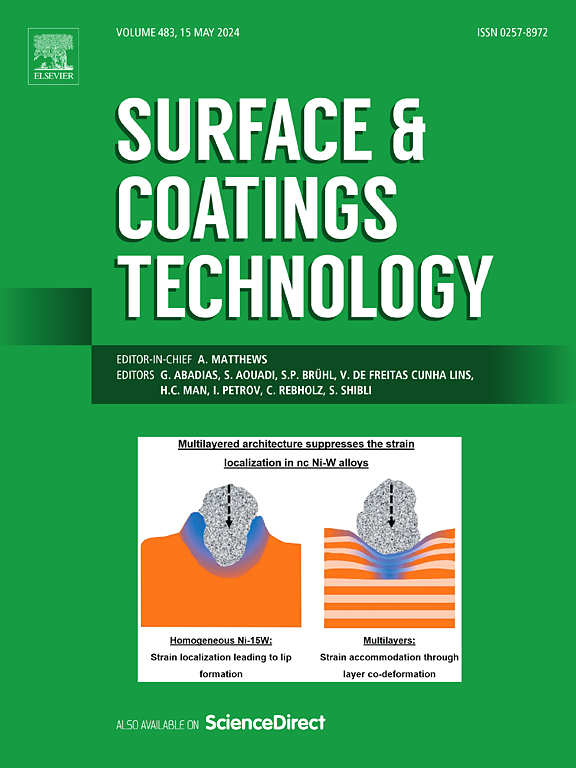超声辅助激光熔覆Mo和C改性cocrni基高熵合金的磨损和磨损腐蚀性能
IF 6.1
2区 材料科学
Q1 MATERIALS SCIENCE, COATINGS & FILMS
引用次数: 0
摘要
长期以来,磨损和腐蚀损伤一直是困扰工程设备使用安全的难题,造成了重大的经济损失,因此迫切需要开发高耐磨、耐腐蚀的复合材料。本文采用超声辅助激光熔覆法制备了cocrni基高熵合金复合涂层。研究了Mo和C的加入以及超声处理对涂层组织、磨损和腐蚀性能的影响。结果表明,Mo和C的掺入促进了高硬度强化相的形成,而原子尺寸的错配则导致了明显的固溶强化。在干滑动条件下,与未经超声处理的涂层相比,超声处理涂层的摩擦系数(COF)降低了~ 0.15,磨损量减少了~ 40%。在3.5% NaCl溶液中进行的磨损腐蚀试验中,超声辅助涂层显示出更低的COF和磨损体积,同时无源电流密度(Ipass)分别显著降低了90.2%和78.9%。显微组织分析表明,超声空化和声流作用细化了晶粒尺寸,促进了富Cr/ mo伴生相的形成,减轻了碳化物的不均匀性。这些微观组织的改进提高了涂层的均匀性和耐磨损、耐腐蚀性能,优化了磨损机理。本文章由计算机程序翻译,如有差异,请以英文原文为准。
Wear and wear-corrosion performance of CoCrNi-based high-entropy alloys modified by Mo and C under ultrasonic-assisted laser cladding
Wear and corrosion damage have long been challenges to the service safety of engineering equipment, resulting in significant economic losses and highlighting the urgent need for the development of highly wear- and corrosion-resistant composite materials. In this study, CoCrNi-based high-entropy alloy composite coatings were prepared using ultrasonically assisted laser cladding. The effects of Mo and C additions, as well as ultrasonic treatment, on the microstructure, wear, and corrosion properties of the coatings were investigated. The results indicate that the incorporation of Mo and C promotes the formation of high-hardness strengthening phases, while the atomic size mismatch induces pronounced solid-solution strengthening. Under dry sliding conditions, the ultrasonically treated coating exhibited a ∼0.15 reduction in coefficient of friction (COF) and a ∼40 % decrease in wear volume compared to its counterpart without ultrasonic treatment. In wear-corrosion tests conducted in a 3.5 % NaCl solution, the ultrasonic-assisted coating demonstrated lower COF and wear volume, along with a remarkable reduction in passive current density (Ipass) by 90.2 % and 78.9 %, respectively. Microstructural analysis revealed that ultrasonic cavitation and acoustic streaming effects refined the grain size and promoted the formation of Cr/Mo-rich associated phases, mitigating carbide inhomogeneity. These microstructural improvements enhanced the coating homogeneity and wear and corrosion resistance, and optimized the wear mechanism.
求助全文
通过发布文献求助,成功后即可免费获取论文全文。
去求助
来源期刊

Surface & Coatings Technology
工程技术-材料科学:膜
CiteScore
10.00
自引率
11.10%
发文量
921
审稿时长
19 days
期刊介绍:
Surface and Coatings Technology is an international archival journal publishing scientific papers on significant developments in surface and interface engineering to modify and improve the surface properties of materials for protection in demanding contact conditions or aggressive environments, or for enhanced functional performance. Contributions range from original scientific articles concerned with fundamental and applied aspects of research or direct applications of metallic, inorganic, organic and composite coatings, to invited reviews of current technology in specific areas. Papers submitted to this journal are expected to be in line with the following aspects in processes, and properties/performance:
A. Processes: Physical and chemical vapour deposition techniques, thermal and plasma spraying, surface modification by directed energy techniques such as ion, electron and laser beams, thermo-chemical treatment, wet chemical and electrochemical processes such as plating, sol-gel coating, anodization, plasma electrolytic oxidation, etc., but excluding painting.
B. Properties/performance: friction performance, wear resistance (e.g., abrasion, erosion, fretting, etc), corrosion and oxidation resistance, thermal protection, diffusion resistance, hydrophilicity/hydrophobicity, and properties relevant to smart materials behaviour and enhanced multifunctional performance for environmental, energy and medical applications, but excluding device aspects.
 求助内容:
求助内容: 应助结果提醒方式:
应助结果提醒方式:


